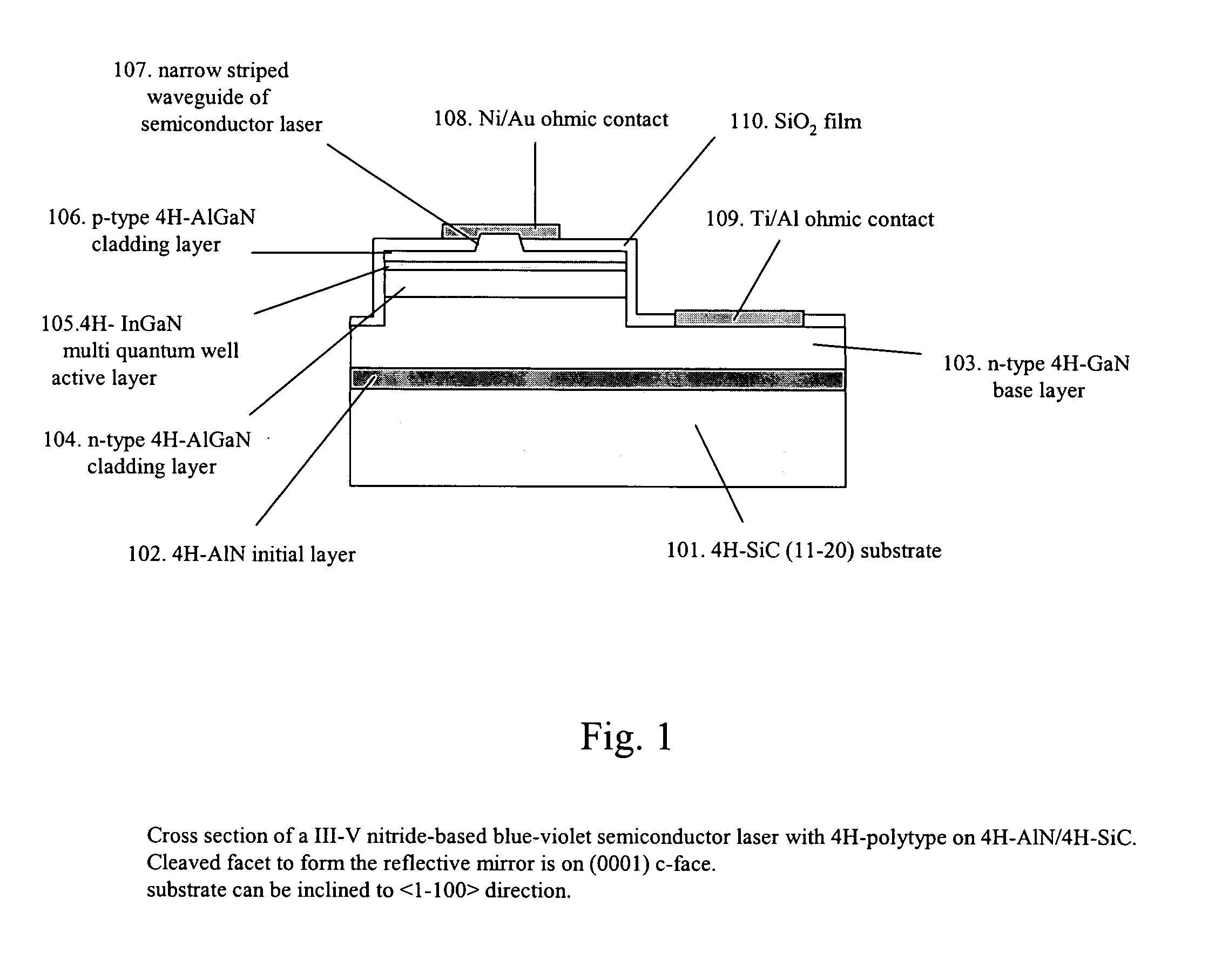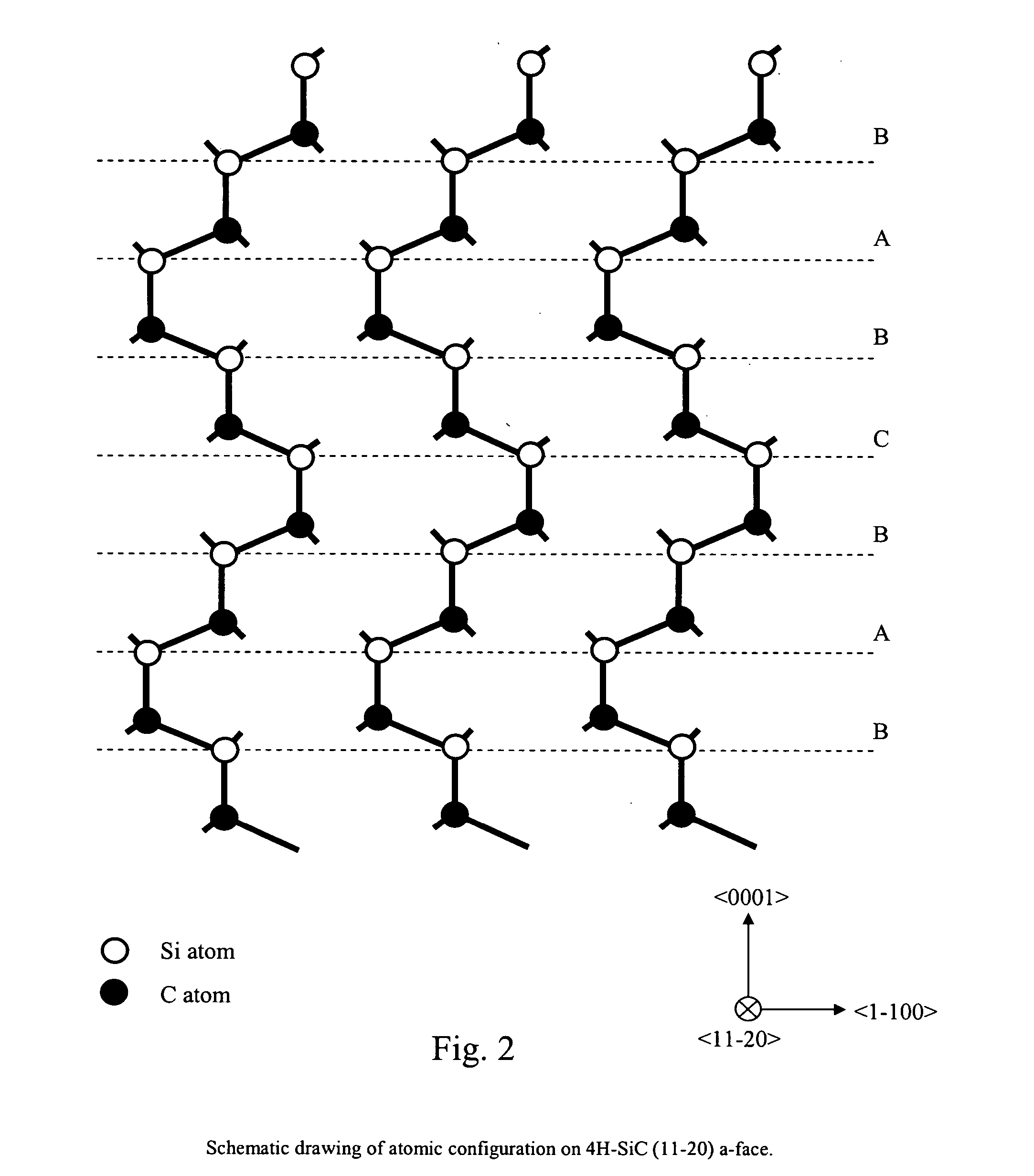4H-polytype gallium nitride-based semiconductor device on a 4H-polytype substrate
a gallium nitride-based semiconductor and polytype technology, applied in semiconductor devices, semiconductor lasers, semiconductor lasers, etc., can solve the problem of unclear crystal quality
- Summary
- Abstract
- Description
- Claims
- Application Information
AI Technical Summary
Benefits of technology
Problems solved by technology
Method used
Image
Examples
first embodiment
[0030] (Device Structure)
[0031] Referring first to FIG. 1, one embodiment of the semiconductor laser of the present invention may be understood in greater detail. In particular, FIG. 1 schematically illustrates a cross sectional view of a blue-violet semiconductor laser in which GaN-based epitaxial structure with 4H polytype is grown on (11-20) a-face of 4H-SiC substrate. The GaN-based epitaxial structure typically consists of p-type Al0.07Ga0.93N cladding layer 106, undoped InGaN multi quantum well active layer 105, n-type Al0.07Ga0.93N cladding layer 104 and n-type GaN base layer 103 And the undoped InGaN multi quantum well active layer 105 is disposed between the p-type AlGaN cladding layer 106 and n-type AlGaN cladding layer 104, and these three layers are formed on the n-type GaN base layer 103 as shown in FIG. 1. Moreover, n-type GaN base layer 103 is formed on the undoped AlN initial layer 102. All of the epitaxial layers have 4H poly type and the layers are grown replicatin...
second embodiment
[0056] Referring next to FIG. 12, there is schematic illustration of a non-polar GaN based blue-violet semiconductor laser on a 4H-SiC (11-20) a-face substrate 1201. Basic epitaxial structures on 4H-SiC (11-20) a-face is identical with the structure as shown in FIG. 1. However, dislocation density in the active layer underneath the waveguide 1208 is further reduced by employing the epitaxial lateral over growth technique. The resultant laser exhibits longer lifetime than that without any lateral growth region owing to the reduction of the dislocations. The emission efficiency from the quantum well in the laser is increased from that on the polar c-face with built-in electric field due to the polarization, which leads to lower threshold current density.
[0057] As shown in FIG. 12, the epitaxial structure of the laser typically consists of an undoped InGaN multi quantum well active layer 1206 formed between a p-type Al0.07Ga0.93N cladding layer 1207 and an n-type Al0.07Ga0.93N claddin...
third embodiment
[0069] Referring next to FIG. 13(a) and (b), non-polar GaN-based blue-violet laser diodes on 4H-SiC (11-20) a-face substrates with two electrodes on the both sides of the laser chip are shown. Epitaxial structure on 4H-SiC (11-20) a-face is basically identical with the structure shown as the first embodiment except for the initial layer. In the first embodiment, the initial layer is AlN, however in this embodiment, the initial layer which is formed on the substrate 1301 is conductive AlGaN layer. And also in this embodiment, the 4H-SiC substrate 1301 is conductive to enable the vertical device configuration. The emission efficiency from the quantum well in the laser on the non polar face is increased from that on the polar c-face with built-in electric field due to the polarization, which leads to lower threshold current density together with low series resistance and operating voltage owing to its vertical device configuration.
[0070] As shown in FIG. 13(a) and (b), the epitaxial s...
PUM
| Property | Measurement | Unit |
|---|---|---|
| thickness | aaaaa | aaaaa |
| thickness | aaaaa | aaaaa |
| length | aaaaa | aaaaa |
Abstract
Description
Claims
Application Information
 Login to View More
Login to View More - R&D
- Intellectual Property
- Life Sciences
- Materials
- Tech Scout
- Unparalleled Data Quality
- Higher Quality Content
- 60% Fewer Hallucinations
Browse by: Latest US Patents, China's latest patents, Technical Efficacy Thesaurus, Application Domain, Technology Topic, Popular Technical Reports.
© 2025 PatSnap. All rights reserved.Legal|Privacy policy|Modern Slavery Act Transparency Statement|Sitemap|About US| Contact US: help@patsnap.com



